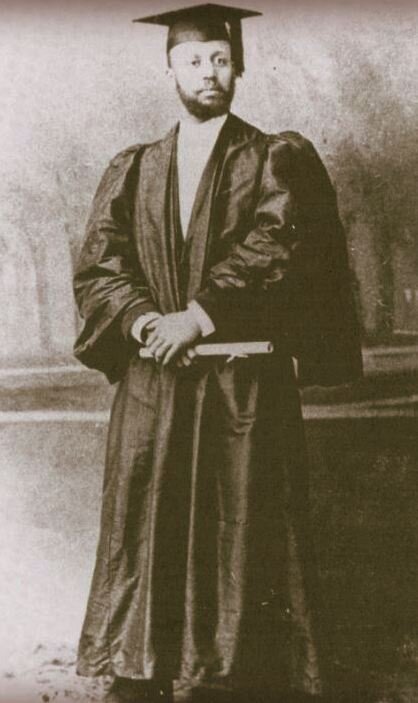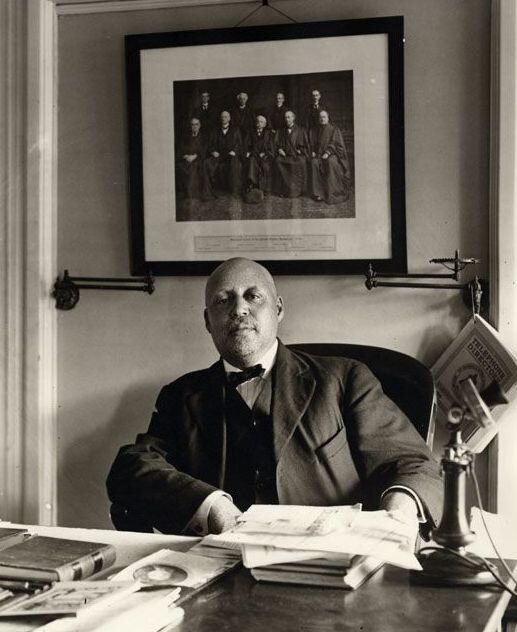Judged By Merit
Judge Robert Terrell & Wife Mary Church Terrell with Robert’s gavel (Smithsonian).
““I have no prejudice against sect or race, but want each individual to be judged by his own merit.” -U.S. Grant 1868”
Visitors to Grant Cottage Historic Site learn about the Grant family and their descendants but there are other figures associated with the end of Grant’s life that also deserve attention. Their meaningful stories and those of their descendants provide valuable historical insight and inspiration. One of those individuals was Harrison Terrell, an African American valet to the general who became his close friend and caregiver. While Harrison’s story itself is fascinating, going from an enslaved life in Virginia to being employed by a former U.S. President, the story of his son and daughter-in-law are no less historically significant and inspiring. Their stories reflect a century of struggle for African Americans and highlight the civil rights movement in the United States.
Harrison Terrell is largely remembered for being a dedicated and faithful caregiver to General Grant in his final days. This is an interesting point because of the pivotal role caregiving played in Harrison’s childhood story. William Henry Harrison Terrell was born into slavery in Orange County, Virginia in the early 1840s. His parents being enslaved house servants, Harrison became the body servant of the plantation owner Buckner Terrell. In the early 1850s, Buckner fell off a ladder breaking his back. Over the next five weeks, young Harrison provided tireless care for Buckner, who eventually succumbed to his injuries. Before his master died, however, Harrison was granted emancipation for his dedicated care.
Harrison left for Richmond, VA, and found work in a hotel there. Three gentleman gamblers hired the young boy as a body servant and he would join them on a gambling tour of the south over the next few years. Harrison married Luisa Ann Coleman and they had a boy, Robert in November 1857 at Glen Cove in Orange County, VA. When the Civil War broke out, the men that Harrison worked for joined the Confederate army and he followed, as did thousands of other free and enslaved African Americans, as a body servant. Harrison witnessed the terrible cost of war as two of the three men he served died during the war. In the final campaigns of the war, Harrison was working in the Confederate camps only miles from where the commander of the Union forces Ulysses S. Grant sat in his headquarters. After the surrender at Appomattox Harrison left the employ of the remaining soldier to seek out a fresh path.
Painting of President Lincoln working on the Emancipation Proclamation at the cottage. (by Jes W. Schlaikjer)
By 1868 Harrison had made his way to Washington DC and landed himself a job as a valet in the home of wealthy banker George W. Riggs. In the 1840s Riggs built a cottage on a large estate a few miles from the White House as a place outside the city for his family, servants, and slaves. This cottage would later become a Presidential retreat and was where President Lincoln wrote the Emancipation Proclamation. Being a personal valet to Riggs meant that Harrison had a close relationship with one of the most wealthy and influential citizens of Washington DC. Upon Riggs death in 1881 Harrison secured a valet position in the new home of Ulysses S. Grant on 66th Street in Manhattan. Over the next few years, Harrison’s relationship with his employer would develop into an intimate friendship.
Interior of the Grant home at 3 East 66th Street in Manhattan, NYC.
Due to the nature of his father’s employment, there were many more opportunities open to Robert than his father could have dreamed of. His education began modestly with attendance at black grammar and preparatory schools, but it must be noted that this was during a period when black individuals had a school enrollment rate of only 10-20% and the illiteracy rate for adult non-whites was 70%. Robert reflected on the formative early years of his education that “we were taught to think for ourselves and… our ambitions and aspirations began to sprout wings and grow.”
Robert traveled to Boston as a young man and took up employment waiting tables to support himself. While waiting tables on the campus of Harvard University some students convinced him to pursue his dream of higher education. Within a few years, Robert had set aside enough money to attend the Lawrence Academy in Groton, MA, a well-established preparatory school. Terrell would have the distinction of being the first black graduate of the school, giving an oration on the eve of the graduation ceremony for the class of 1880. The oration was on Touissant L’ Ouverture, a prominent leader in the Haitian Revolution. A fitting figure for Robert to have chosen as L’Ouverture was born into slavery but rose to help advance his nation towards freedom, equality, and independence. Robert had chosen to recite from memory a lecture by famous abolitionist Wendell Phillips given in 1861 during a war that would ultimately end slavery in the U.S.. The lecture began with the following words:
“I have been requested to offer you a sketch… of one of the most remarkable men of the last generation—the great St. Domingo chief, Toussaint L’Ouverture… a Negro soldier and statesman, which I offer you as an argument in behalf of the race from which he sprung. I am about to compare and weigh races… to convince you that the Negro race, instead of being that object of pity or contempt which we usually consider it, is entitled, judged by the facts of history, to a place close by the side of the Saxon…races love to be judged in two ways—by the great men they produce, and by the average merit of the mass of the race.…. I attempt… to convince you that the Negro blood, instead of standing at the bottom of the list, is entitled, if judged either by its great men or its masses, either by its courage, its purpose, or its endurance, to a place as near ours [white] as any other blood known in history.”
The choice to share the inspiring story of the courageous pursuit of liberty and equality for the Haitian people seemed to expose the ambitions of young Robert in the pursuit of justice. Robert took the monumental step of enrolling at Harvard University. It would be the task of supporting himself financially that would be one of his greatest obstacles to pursuing higher education at such an elite school. He continued working jobs as a waiter, working long hours and being as frugal as possible. It would be in his junior year in 1883 that he received some support from his father’s employer.
General Grant, now a partner in a Wall Street firm, took an active interest in the progress of his valet Harrison’s son. On May 20, 1882, he sent the following letter to Roland Worthington the newly appointed Collector of Customs for the Port of Boston:
“After my congratulations upon your appointment and confirmation as Collector… allow me to ask of you if consistent with your views and the public good. I have living with me a Butler a colored man by the name of Terrell. He has a son now working his way through Harvard. I believe he is now about entering the junior class. While pursuing his course of studies he has to earn his own living. This he does by work during vacation and earning what he can in the interval, he will present this letter—his name is Robert Terrell—and ask employment in the Custom House such as he can do without interrupting his course. Terrell’s letters show him to be a young man of good ability and of the right kind of aspirations. If you can give him a position to help him he will appreciate the kindness and I will also.”
Boston Customs House
Grant had always put a high priority on education. During the Civil War he saw to the establishment of schools for refugees from enslavement. After the war Grant supported the work of the Freedman’s Bureau which included the establishment of schools for African Americans. It was the first Commissioner of the Bureau Gen. Oliver Otis Howard who established the black college Howard University in 1867. In April 1880 Grant visited another black college, Straight University, established a decade earlier in New Orleans, LA, and addressed those present:
"It is a good sign to see such a university as this attended by colored people who were for so long deprived of any such advantage. Those who have gone before you had no such advantages. But by the gift of these institutions, these here are taking the first great step towards improving the advantages guaranteed to them by the constitution.”
Straight University Graduates
In the summer of 1883, while spending quality time with his family at their Long Branch, NJ cottage Grant remained invested in the future of Harrison’s son. Grant sent another request for position to Worthington in Boston this time commending the young man’s courage and ability independent of his race:
“May I request you, as I did last year, to employ R. H. Terrell during the vacation in the Boston Custom House. As you are aware Terrell is a colored man now in the Senior class at Harvard and has to earn his own living while prosecuting his studies. My special interest in him is from the fact that his father—a most estimable man—is my butler, beside I should feel an interest in any young man, white or colored, who had the courage and ability to graduate himself at Harvard without other pecuniary aid than what he could earn.”
Robert Terrell at Harvard graduation 1884
Richard T. Greener, who had Frederick Douglass as a mentor, became the first black student to graduate with a degree from Harvard in 1870. He also later in life served as secretary of the Grant Monument Association tasked with raising funds to build a permanent tomb for U.S. Grant in New York City. Fourteen years after Greener’s graduation Robert graduated from Harvard as one of only a handful of black individuals to have done so. He further distinguished himself by being the first black student to graduate Magna Cum Laude and the first with the honor of joining the commencement procession and giving the oration.
Harrison with Ulysses Grant at Drexel Cottage on Mt. McGregor in 1885
Harrison with Gen. Grant’s empty chair at Mt. McGregor after his death.
While Robert’s dedication was helping him achieve unprecedented educational success, his father’s dedication was stabilizing a failing hero. As cancer ravaged General Grant’s body, Harrison’s role became one of constant attendant and nurse. Knowing time was short, General Grant gave Harrison a letter of recommendation only weeks before his death in July 1885 stating: “I have had abundant reason to be satisfied with your attention, integrity and efficiency. I hope you may never want for a place.” Grant’s son Fred also reached out a short time later on behalf of the family to thank Harrison and offer any assistance they could in his future as he was leaving their employ. Using Grant’s endorsement Harrison had secured a position within the Paymaster General’s office at the War Department in Washington DC by 1886. Within three years Harrison was an Assistant Messenger at the War Department with an annual salary of $720, higher than the average wage for most U.S. citizens at a time when income for African Americans per capita in the US was 34% that of white Americans. Being in Washington would give Harrison the chance to see his son who would soon establish himself in the city.
The accomplishments Robert had already achieved were impressive, but he showed no signs of slowing down in his pursuit to further his education and career. For the next five years, he taught at the M Street High School while taking evening classes at Howard University Law School. His dedication to his studies was recognized when the Robert H. Terrell Law School was established offering evening classes from 1931-1950. Graduating as valedictorian with a Bachelor of Law degree in 1889, Robert was appointed to a position in the U.S. Treasury Department by President Harrison. He continued his studies to achieve a masters degree the following year. He would go on to serve as principal of the M Street School.
The M Street High School - One of the first African American high schools in America.
While teaching at the M Street School Terrell met and married a fellow teacher who would match his zeal for justice and equality in Mary Eliza Church. Mary’s parents Robert and Luisa Church had been born into slavery but escaped when their city of Memphis, TN fell to Union forces and was placed under the command of General Grant in 1863. Her father became a successful businessman known as the first black millionaire of the south and her mother operated a business, both pioneers for their time. Having the means, Mary’s parents encouraged her to seek a good education. She was sent to elite schools in Ohio before attending Oberlin College, the first college to accept both African American and female students. Mary would be one of the earliest female African American college graduates when she earned her full bachelors degree in 1884. She added a masters degree in education four years later, becoming one of the first African American women to do so. She and fellow Oberlin graduates Anna Julia Cooper and Ida Gibbs Hunt would become close associates in the struggle for gender and race equality. Mary’s career began with teaching positions in Ohio and Washington DC before she took time to study in Europe, learning three languages. After she returned to the U.S. Mary became the first woman appointed to the District of Columbia Board of Education.
As General and President Ulysses S. Grant worked towards advancing and ensuring civil rights for African Americans during the 1860s-70’s but admitted in his second inaugural address that “The effects of the late civil strife have been to free the slave and make him a citizen. Yet he is not possessed of the civil rights which citizenship should carry with it. This is wrong, and should be corrected.” Much of what had been gained was lost or was threatened after Grant’s time in office. Racial violence such as the abhorrent practice of lynching was prevalent and the Jim Crow laws were denying equality to African Americans. It was left to Robert and Mary’s generation to take up the mantle and they did so in impressive fashion.
1872 Presidential campaign booklet highlighting U.S. Grant’s commitment to the “Colored People” Read Here
““I sympathize most cordially in any effort to secure for all our people, of whatever race, nativity, or color, the exercise of those rights to which every citizen should be entitled.” -President Grant”
Mary Terrell’s NACW “Lifting As We Climb” pin. (Smithsonian)
Mary was spurred into activism when she learned of the lynching of childhood friend Thomas Moss outside of Memphis, TN in 1892. Together with Ida Wells she began an anti-lynching campaign, writing and speaking out on the subject. That same year Mary, along with other female African American leaders, formed the Colored Women’s League which later became the National Association of Colored Women (NACW). Twice Mary served as president for the organization that was dedicated to improving the lives of black women in America with their motto being “Lifting as we climb.” She gave a trilingual speech at the 1904 International Council of Women in Germany as the only African American woman to do so, highlighting the issues facing black women. In 1909 Mary was a founding member of the National Association for the Advancement of Colored People (NAACP). Supported by fellow leaders like W.E.B. Dubois, Booker T. Washington, and Susan B. Anthony Mary became a prolific speaker, writer, and poet, powerfully advocating for equality in all she wrote:
“Surely nowhere in the world do oppression and persecution based solely on the color of the skin appear more hateful and hideous than in the capital of the United States, because the chasm between the principles upon which this Government was founded, in which it still professes to believe, and those which are daily practiced under the protection of the flag, yawn so wide and deep.”
Mary Terrell’s NACW badge. (Smithsonian)
As Mary was breaking ground in her efforts towards civil rights, Robert was breaking ground in his own career. In 1901 President Roosevelt appointed Robert as justice of the peace for the District of Columbia and later under President Taft he would become the first Federally-appointed African American municipal judge for the district. Robert also helped found the American Negro Academy and lectured and advocated for the honest scholarship of African American history. Throughout his career Robert never forgot the help he received at a crucial time in his life from General Grant, attending and speaking at annual birthday celebrations in his benefactor’s honor at the Loendi Club of Pittsburg, PA. In a September 22, 1903 speech in Memphis, TN for the anniversary of the Emancipation Proclamation Robert extolled the monumental importance of the historic order but added that:
“It has not, however, fulfilled the wishes, the hopes, and the final expectations of… those who fought so desperately on the field of battle to make its provisions effective. And our cup is all the more bitter, when the thought comes to us that among those who bled and died that the country might be saved and their kinsmen free were black men, the bravest soldiers that ever wore a uniform.”
During the Civil War General Grant supported the enlistment of African Americans in the Union army stating in a letter to President Lincoln that “we have added a powerful ally. They will make good soldiers.” Over 200,000 African Americans would serve in the U.S. forces during the conflict that would ensure their freedom.
Robert continued his speech covering the history of African Americans in America and highlighting the impressive advancements since emancipation. Despite the progress, he reminded the audience of the sobering realities of the ongoing struggle:
“At no time since the Civil War has the future of the Negro seemed so dark and so uncertain as today. We are in thick weather and on a stormy sea, and many wise and thoughtful people fear for our safety. But I believe behind the clouds the sun is shining and is bound to bring in God's final day of light. The older ones among us have seen darker days than these… And shall we with forty years of freedom behind us and forty years of opportunity to strengthen and develop us be less courageous than they were?”
Early in his first term, President Grant identified the main issue underlying the struggles of African Americans when he wrote: “The present difficulty, in bringing all parts of the United States to a happy unity and love of country grows out of the prejudice to color. The prejudice is a senseless one, but it exists.”
Robert echoed Grant’s statement concluding that:
NAACP anti-lynching flag that flew from 1920-1938 after lynchings. (Library of Congress)
“Our hopes have not been realized and we are forced to the conclusion that the brutal treatment of the Negro is not due to… politics. Nothing less than an intolerant race hatred could be the moving influence of such ferocity and fiendishness as characterize the lynchings of the black man in this country… I can see for the American people no permanent peace, no ease of conscience until the Negro question is settled, and settled right.”
It was clear that a man who had a career in justice saw it as the way to peace. Regardless of prejudice Robert made it clear that African Americans had responsibility for their own future, to actively seek an education and a better life. Robert made it clear that major accomplishments in the struggle for equality had not been simply handed to their ancestors and future gains would require significant resolve and action going forward.
Mary & her daughter Phyllis
The Terrell’s determination and accomplishments were even more impressive when considering the personal hardships and loss they endured. In the 1890s the couple had to cope with the devastating loss of three children in infanthood. The flame of the preceding generation would also go out when in 1906 sixty-five-year-old Harrison fell down a flight of stairs while making a delivery and tragically died. The Terrell’s focused on their surviving daughter Phyllis who would follow in her mother’s footsteps with a lifetime of activism. As a teenager, Phyllis would join her mother in the National Woman’s Party Silent Sentinels protests at the White House to advocate for women’s suffrage.
Mary Terrell protesting segregation in her later years.
The Silent Sentinels protest at the White House.
Robert continued to serve honorably as a judge even after a series of strokes that eventually led to his death in 1925. After her husband’s passing Mary continued her quest for equality and justice for decades. She tirelessly advocated desegregation and voting rights, lecturing and demonstrating to the very end. In 1953 she was given a White House reception for her 90th birthday. Even though she had seen great signs of progress in women’s suffrage and desegregation, she knew what she strove for her entire life was not done and vowed to continue the fight. Mary died two months later and would join her husband in the Terrell plot of the Lincoln Memorial Cemetery and a few miles away rests Robert’s father in National Harmony Memorial Park. Three individuals whose lives began in a time of slavery but who rose from humble beginnings and endeavored for a better life, not just for themselves but for countless others. The legacy of the Terrell family lives on in those who continue to be inspired by their story. Mary’s timeless words of determination and hope will continue to influence generations to come as the quest for equality continues…
"And so, lifting as we climb, onward and upward we go, struggling and striving, and hoping that the buds and blossoms of our desires will burst into glorious fruition 'ere long. With courage, born of success achieved in the past, with a keen sense of the responsibility which we shall continue to assume, we look forward to a future large with promise and hope. Seeking no favors because of our color, nor patronage because of our needs, we knock at the bar of justice, asking an equal chance." - Mary Church Terrell 1898
Sources:
120 Years of American Education: A Statistical Portrait Edited by Tom Snyder, National Center for Education Statistics, 1993
The Black-White Income Gap in 1880 by Kenneth Ng & Nancy Virts in Agricultural History, Vol. 67, No. 1 Winter 1993
The Papers of Ulysses S. Grant
The History of Lawrence Academy at Groton: 1792 to 1992
What a Woman Ought to Be and to Do: Black Professional Women Workers During the Jim Crow Era by Stephanie J. Shaw · 2010
Black Foremothers: Three Lives by Sterling, Dorothy – 1988
A Glance at the Past and Present of the Negro; An Address by Robert H. Terrell Sept. 22, 1903
Evening Star (Washington, D.C.) - July 06, 1906
The Detroit Tribune - October 10, 1953
































